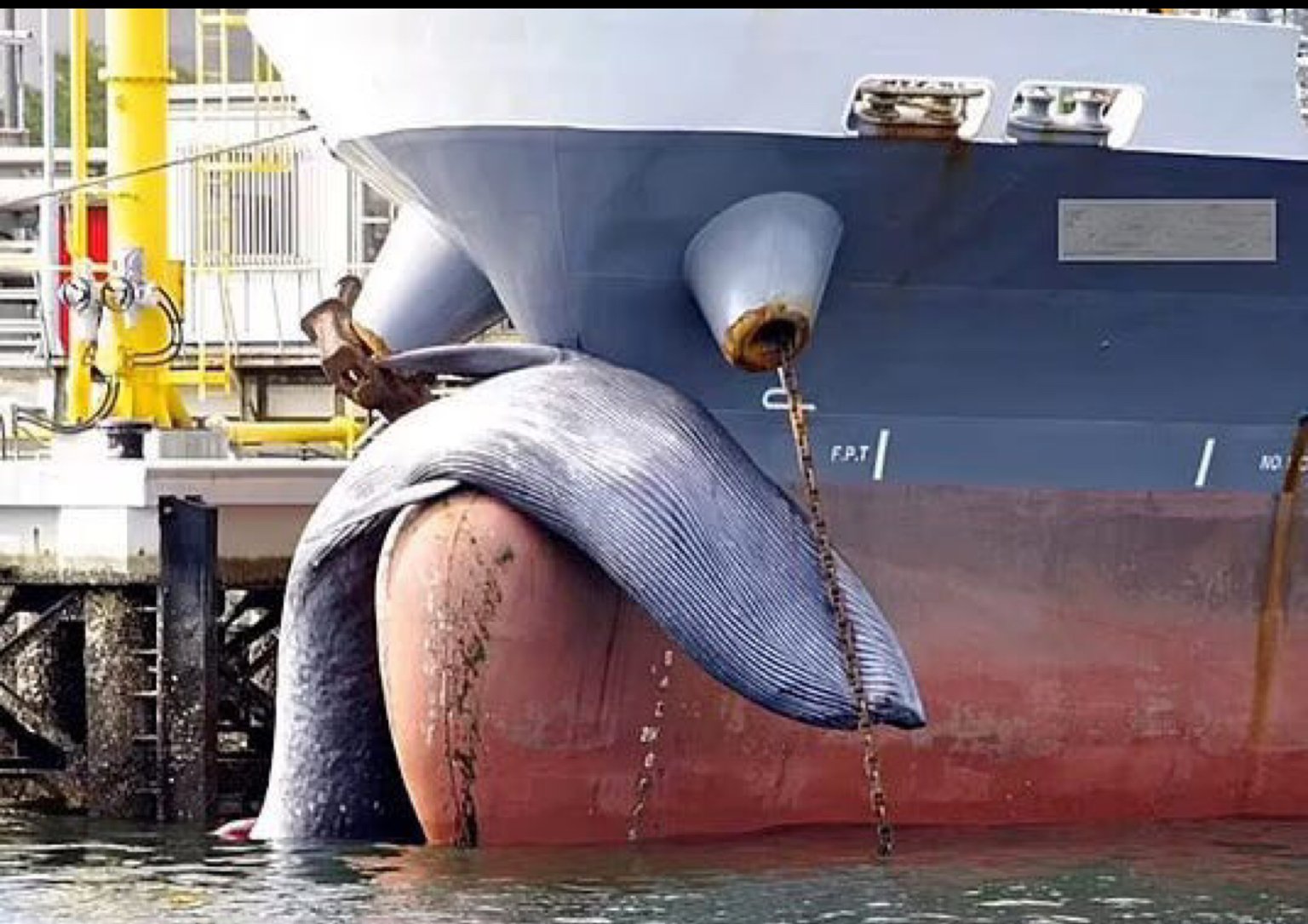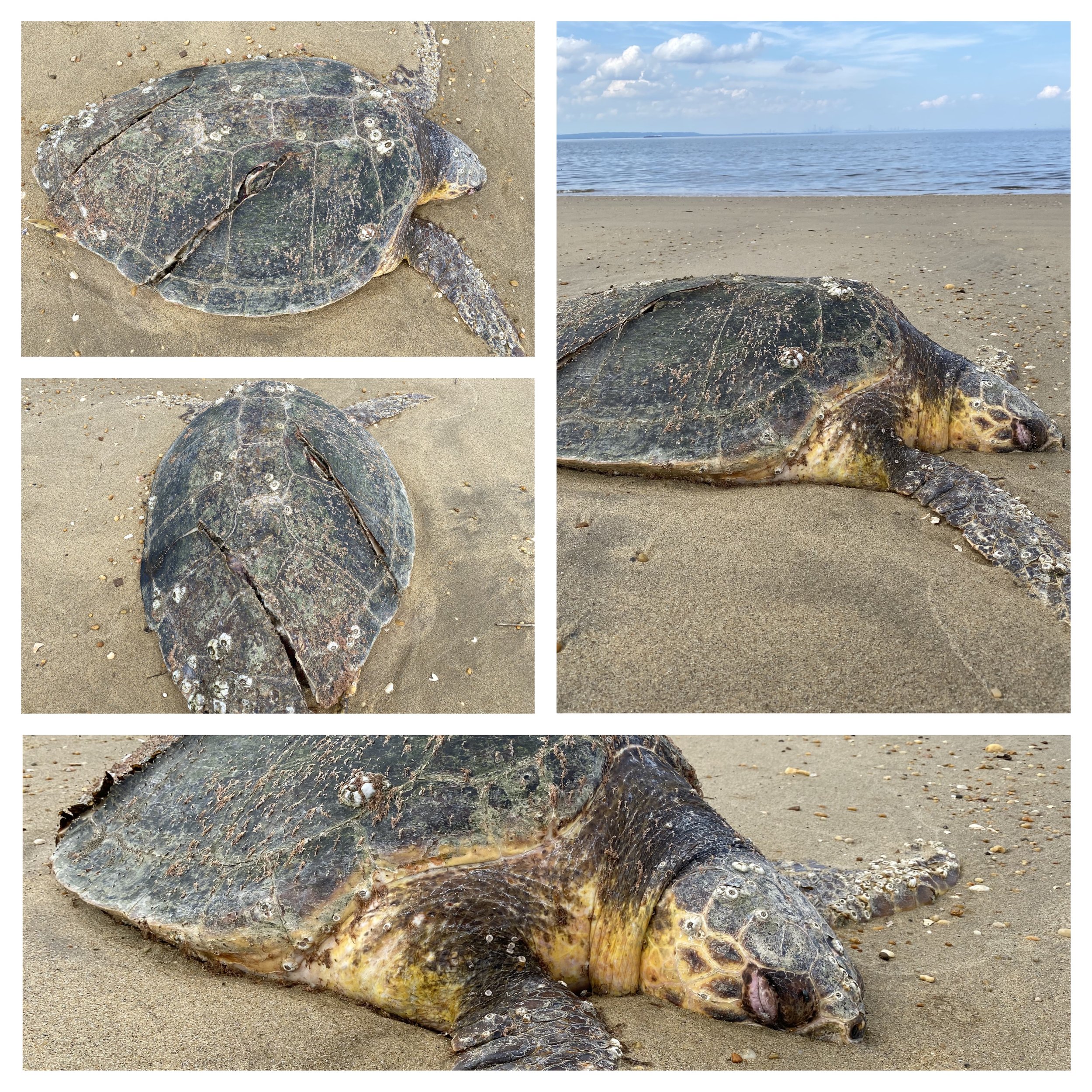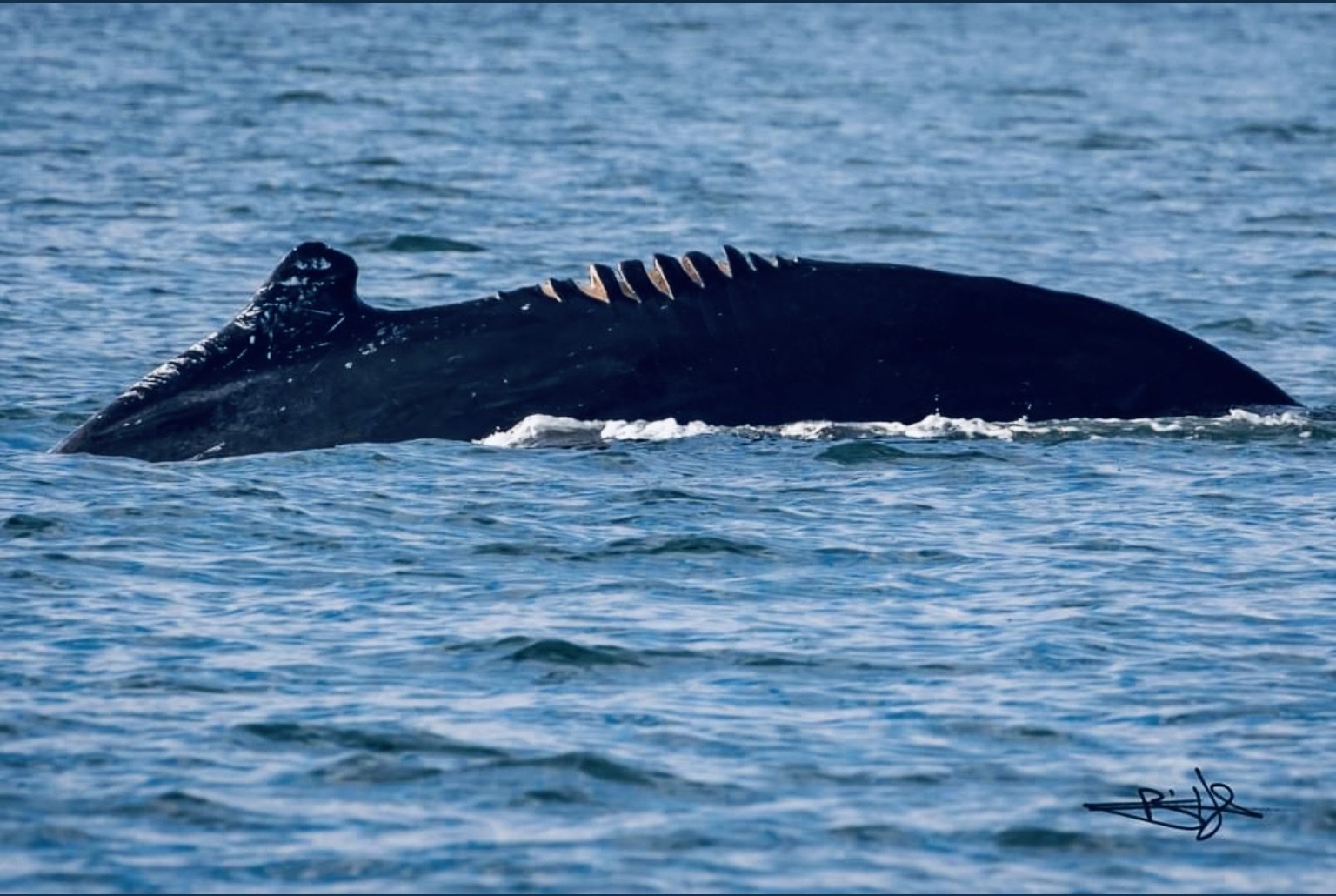Collisions with Ships
Ships hitting whales, dolphins and sea turtles
It’s like a hit and run death or injury to a human by a car, but in this case it’s happening to coastal wildlife.
Shipping traffic has increased along coastal United States (even as small as a jet ski), plus increasing speed of watercraft and the expanding sizes of cargo or tanker vessels often means death and injury for many slow moving whales and sea turtles who might be just resting, migrating or seeking a meal along the coast.
During summer 2021, a sub-adult male loggerhead sea turtle (Caretta caretta) washed up dead on a beach in Keansburg, NJ, located along Raritan Bay. The turtle’s carapace had obvious signs and cuts that it had been injured from colliding with a small boat.
The northwest Atlantic Ocean population of Loggerhead sea turtles are considered threatened in the United States of America and is listed under the Endangered Species Act.
Even dolphins can collide with the propellors of a speeding boat along the Jersey Shore. This poor dolphin washed up dead in Port Monmouth in September 2019.
How do animals get struck by ships?
Large ships are unlikely to see a whale, dolphin or sea turtle. Due to the large size and speed of a ship, it may be unable to divert course even if they do see a marine mammal or sea turtle. In addition, a resting sea turtle may appear as a mat of algae in the water. A speeding ship or boat will hit a sea turtle and not even know it, because the captain will think it was traveling through seaweed.
A large ship also creates something called a ‘bow null effect’ blocking the engine noise by the bow, creating a quiet zone in front of the vessel, and leaving an aquatic animal unaware of the pending hazard.
Collisions with vessels can be fatal. When a whale or sea turtle is hit by a ship or another vessel, these gentle creatures are likely to die or suffer a horrific injury. Ship collisions have been identified as a significant human cause of baleen whales (mysticete) mortality [1].
Whales and sea turtles are often unable to avoid ships, because many species move slowly in the water. Collisions often go unnoticed or unreported by the vessel’s captain, which means the deaths of whales and sea turtles are far higher than figures suggest. Sometimes injuries may not be life threatening right away, but a whale or sea turtle will die months or years later.
Whales slowly swimming, resting, or sleeping (logging) just below the surface of the water may be struck by speeding boats near the coast or within an estuary. Farther out in the ocean larger ships, including cargo ships and tankers, present an even greater threat of death and injury.
Whales and sea turtles spend most of their time underwater. So animals can be difficult to spot just below the surface, particularly at night or in rough ocean or choppy coastal waters.
An individual whale or sea turtle may also not see a vessel as a threat in urban waters where animals are often accustomed or familiar with boat noises around them, just like a person living on a busy city street. But life in urban waters can be deadly. Whales live in a world of sound, this is how many species of cetaceans find food and a mate, but large ships can cause a sound effect in the water called a ‘bow null’ effect. Load engine noise locate at the rear of the vessel is frequently masked or blocked by the front of the vessel. Many times a whale or sea turtle will not even hear an approaching vessel until it is too late.
A boat strike fractured the skull from the nares (nostrils) to the mandible (upper jaw)
Blunt trauma occurs when the vessel hull strikes a marine mammal or sea turtle straight on, resulting in bruising or broken bones or death.
Propeller strikes cause deep cuts in the tissue (or flesh) of whales and sea turtles. Sometimes this injury may result in a series of scars or death depending if main arteries or the spinal cord are cut.
Beached whales or sea turtles with large wounds from propellers, missing fins and other body parts are all evidence of a deadly encounter with a boat or ship in the water.
The bow or front section of a boat’s hull is like a battering ram, easily smashing the bones and body of a sleeping or tired whale, sea turtle or another unsuspecting sea creature.
The remans of a juvenile humpback whale found on a beach at the entrance to New York Harbor in August 2019. The young whale likely collided with a cargo ship near the entrance to the harbor.
“Whales feed in close proximity to the entrance of the Port of New York and New Jersey, creating potentially dangerous situations for both vessels and whales. Documenting humpback whale presence and identifying the risks are crucial for both short- and long-term management,” wrote researchers at George Mason University in Virginia and Gotham Whale, a nonprofit group in New York City.
Published in the journal Marine Policy, authors Danielle M. Brown, Paul L. Sieswerda and E.C.M. Parsons report humpback whale sightings – along with strandings of dead whales – have substantially increased around the apex of the New York Bight since 2011. The team makes a case for stepping up whale monitoring in the Bight, for both conservation and the safety of mariners and whales.
Some 45% of sightings recorded by Gotham Whale were less than 3 kilometers (1.8 miles) from shore, and analysis of automatic identification system data from passing vessel traffic showed that in 2016, 95% of sightings were within 100 meters (328′) of at least one vessel transit.
Commercial cargo ships and tankers can move very close to the coast where whales sometimes feed. This picture was taken at Sandy Hook, Gateway National Recreation Area, North Beach, at the entrance to New York Harbor during August 2019.
SOME SOLUTIONS:
Slow down! Have year-round slow zones. Just like vehicles around a school zone or on crowded city streets, boats and other vessels need to slow down in areas where there is a high probability of marine mammal or sea turtle activity (especially feeding areas). Research shows that boats and ships that operate at slower speeds (10kts or less) significantly reduce the risk of mortally wounding a whale if struck. Slowing down may also provide the animal with an increased reaction time to move away from the vessel. An example where this has worked well is in the St. Lawrence River estuary in Canada. Ship pilots significantly reduced their speed across the area, with 72 percent of the transits in 2014 occurring at speeds less than 13.6 miles per hour. Since 2014, there have been no or few whale strikes reported.
Where shipping lanes converge outside New York Harbor, NOAA calls for vessel speed restrictions to protect the highly endangered northern right whale during its migration season from Nov. 1 through April 30.
NOAA Fishers has adopted a seasonal speed restriction in certain areas during the winter, but this policy needs to be reviewed for year-round marine mammal activity at a wider area. As of now, all vessels 65 feet (19.8 meters) or longer must travel at 10 knots or less in certain locations (Seasonal Management Areas) along the U.S. east coast at certain times of the year to reduce the threat of ship collisions with endangered North Atlantic right whales. The purpose of this regulation is to reduce the likelihood of deaths and serious injuries to these endangered whales that result from collisions with ships.
A juvenile humpback whale seen around New York Harbor in 2021 with cuts and scars from a propeller wound from a large ship. Picture from Gotham Whale.
Better technology. Technology needs to be in place that warns a ship’s captain of a potential strike. In 2017, the Benioff Ocean Initiative, a team of marine biologists and technologists from universities and research labs around the United States, received a 1.5 million grant to develop a system that detects endangered blue whales using acoustic and thermal sensors and sends alerts to nearby boat captains. The goal is to reduce collisions between big ships and the world's largest animal in California's Santa Barbara Channel, a historical hotspot for encounters that frequently prove fatal for the whales. Additional funds need to be devoted to developing this technology on both coasts of the United States.
Better mapping. There needs to be a national strategy by the U.S. government to know exactly where marine mammals and sea turtles are most in danger, by mapping the risk of vessel strikes on a national scale. Reported strikes usually coincides with areas of heavy ship traffic and in areas of shipping traffic lanes. Hot spots can then be identified. To a certain point, this is currently being done by the International Whaling Commission (IWC) but uninfluenced and objective organizations in the United States should also be conducting this activity to make sure the data is correct.
A Warning System for Whales. In Cape Cod Bay, the US National Oceanic and Atmospheric Administration (NOAA) has established a warning system for whales in the navigation corridor to Boston. Buoys are equipped with hydrophones capable to pick up the calls of whales. If a whale is detected, a signal is sent to ships so they can slow down in a particular sector. This activity should be expanded to other waters along the east coast.
Lookouts on ships. Ship captains can also post lookouts to scan waters for nearby marine mammal or sea turtle activity. If the lookout sees a spout, tail, or breaching whale, the person can tell the captain to slow down. Some whales may dive for 20 minutes or more while searching for food. If one whale is seen, many more could be close - maybe too close to a boat and its spinning propellers and powerful steel hull.












